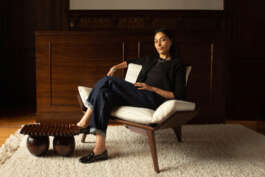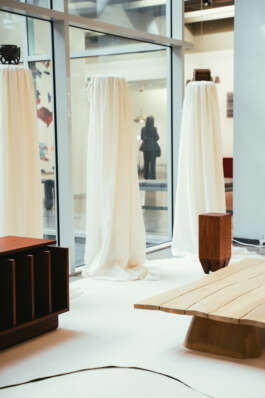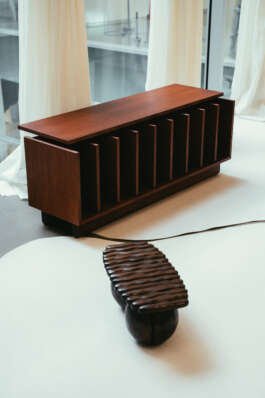



© Adel Slimane Fecih
COLLECTIBLE In-Depth
Kalo Rakoto
March 2025
This series, COLLECTIBLE In-Depth, unveils the backstage of contemporary creation. Tackling various topics from personal designer processes to the position of collectible design on the global design market, COLLECTIBLE In-Depth offers different views to suit all tastes. Today we speak with Kalo Rakoto.
C: How did you get into collectible design? Why did you focus your practice on this type of design
rather than industrial design?
Kalo Rakoto: Before getting into design, I worked in the fashion and luxury industry for almost a decade alongside
talented designers as a textile engineer. This experience shaped my vision and gave me a strong sense of detail and precision. At the same time, it allowed me to see the inner workings of an industry—its implications and consequences—from the inside. When I decided to create on my own, my approach was quite the opposite: I wanted to work at my own pace, take the time to immerse myself in an intimate creative process, and craft lasting objects on a small scale. That’s when I chose to focus on collectible design.
C: How does your approach to contemporary collectible design reflect current cultural or societal trends?
KR: I come from a mixed heritage, having grown up between Madagascar and France. This dual identity is an integral part of me, and it naturally manifests in my work. Through my pieces, I seek to challenge the narratives surrounding non-Western countries, which are still often viewed through a colonial lens. These questions are at the heart of a broader global conversation on accountability and identity. The show Interstices, curated by Liv Vaisberg during the Design Biennale Rotterdam 2025, directly addressed this topic. I had the opportunity to showcase some of my pieces there.
C: When designing a collectible object how do you think about its various environments where it can end up?
KR :Fashion really shaped my mind. When I create an object, it’s like clothing—it can end up in various outfits depending on the events. I start by building the framework: first, focusing on functionality, then on artistic direction. The goal is always to create a sculptural piece that can stand on its own while enhancing its environment.
C: If you were to collaborate with someone outside of the design scene, from another industry, who would you pick?
KR: I would choose Soa Ratsifandrihana, a contemporary dancer based in Brussels as well. She is also exploring identities and the dialogue between the past and present. I would love to create a scenography for one of her performances. Her work is a great source of inspiration.

© Adrian Maurice

© Adrian Maurice

© Adel Slimane Fecih
COLLECTIBLE In-Depth
Kalo Rakoto
March 2025
This series, COLLECTIBLE In-Depth, unveils the backstage of contemporary creation. Tackling various topics from personal designer processes to the position of collectible design on the global design market, COLLECTIBLE In-Depth offers different views to suit all tastes. Today we speak with Kalo Rakoto.
C: How did you get into collectible design? Why did you focus your practice on this type of design
rather than industrial design?
Kalo Rakoto: Before getting into design, I worked in the fashion and luxury industry for almost a decade alongside
talented designers as a textile engineer. This experience shaped my vision and gave me a strong sense of detail and precision. At the same time, it allowed me to see the inner workings of an industry—its implications and consequences—from the inside. When I decided to create on my own, my approach was quite the opposite: I wanted to work at my own pace, take the time to immerse myself in an intimate creative process, and craft lasting objects on a small scale. That’s when I chose to focus on collectible design.
C: How does your approach to contemporary collectible design reflect current cultural or societal trends?
KR: I come from a mixed heritage, having grown up between Madagascar and France. This dual identity is an integral part of me, and it naturally manifests in my work. Through my pieces, I seek to challenge the narratives surrounding non-Western countries, which are still often viewed through a colonial lens. These questions are at the heart of a broader global conversation on accountability and identity. The show Interstices, curated by Liv Vaisberg during the Design Biennale Rotterdam 2025, directly addressed this topic. I had the opportunity to showcase some of my pieces there.
C: When designing a collectible object how do you think about its various environments where it can end up?
KR :Fashion really shaped my mind. When I create an object, it’s like clothing—it can end up in various outfits depending on the events. I start by building the framework: first, focusing on functionality, then on artistic direction. The goal is always to create a sculptural piece that can stand on its own while enhancing its environment.
C: If you were to collaborate with someone outside of the design scene, from another industry, who would you pick?
KR: I would choose Soa Ratsifandrihana, a contemporary dancer based in Brussels as well. She is also exploring identities and the dialogue between the past and present. I would love to create a scenography for one of her performances. Her work is a great source of inspiration.

© Adrian Maurice

© Adrian Maurice
Contact
info@collectible.design
VIP PORTAL
EXHIBITOR PORTAL
PRIVACY POLICY
© 2025 Collectible
Contact
info@collectible.design
VIP PORTAL
EXHIBITOR PORTAL
PRIVACY POLICY
© 2025 Collectible